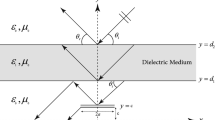Abstract
The equivalent dipole-moment method (EDM) is extended and applied in the analysis of electromagnetic (EM) scattering by arbitrarily shaped perfect electric conductor (PEC) targets coated with electric anisotropic media in this paper. The scattering targets are discretized into tetrahedral volume elements in the material region and into triangle patches on the conducting surface, where the volume-surface integral equation (VSIE) is set up. Then the method of moments (MoM) is employed to solve the VSIE. In the impedance matrix, the near field interaction elements are computed by the conventional MoM while the far field interaction elements are modeled by the EDM. The proposed approach is sufficiently versatile in handling arbitrarily shaped objects coated with general electric anisotropic media and is easily constructed through a simple procedure. Numerical results are given to demonstrate the accuracy and efficiency of this method.




Similar content being viewed by others
References
J. C. Monzon, “On a surface integration representation for homogeneous anisotropic regions: Two dimensional case,” IEEE Transactions on Antennas and Propagation 36, 1401–1406 (1988).
B. Beker and K. R. Umashankar, “Analysis of electromagnetic scattering by arbitrarily shaped two-dimensional anisotropic objects: combined field surface integral equation formulation,” Electromagnetics 9, 215–229 (1989).
G. Kobidze and B. Shanker, “Integral equation based analysis of scattering from 3D inhomogeneous anisotropic bodies,” IEEE Antennas and propagation society international symposium, Columbus USA, 633–636 (2003) 22–27 June.
Y. L. Geng, X. B. Wu, and L. W. Li, “Characterization of electromagnetic scattering by a plasma anisotropic spherical shell,” IEEE Antennas and Wireless Propagation Letters 3, 100–103 (2004).
H. C. Chen and D. K. Cheng, “Scattering of electromagnetic waves by an anisotropic plasma-coated conducting cylinder,” IEEE Transactions on Antennas and Propagation 12, 348–353 (1964).
X. Q. Zhu, Y. L. Geng, and X. B. Wu, “Application of MOM-CGM-FFT method to scattering from three-dimensional anisotropic scatterers (in Chinese),” Chinese Journal of Radio Science 17, 209–215 (2002).
B. Shanker, S. K. Han, and E. Michielssen, “A fast multipole approach to analyze scattering from an inhomogeneous bianisotropic cylindrical object embedded in a chiral host,” Radio Science 33, 17–31 (1998).
S. N. Makarov, Antenna and EM modeling with MATLAB, chapter-3 (a join Wiley and Sons: New York, 2002), pp. 39–42.
J. S. Y. Köksoy, V. V. S. Prakash, and R. Mittra, “Efficient generation of method of moments matrices using the characteristic function method,” IEEE Transactions on Antennas and Propagation 52, 3405–3410 (2004).
J.-D. Yuan, C.-Q. Gu, and G.-D. Han, “Efficient generation of method of moments matrices using equivalent dipole-moment method,” IEEE Antennas and Wireless Propagation Letters 8, 716–719 (2009).
S. M. Rao, D. R. Wilton, and A. W. Glisson, “Electromagnetic scattering by surfaces of arbitrary shape,” IEEE Transactions on Antennas and Propagation 30, 409–418 (1982).
D. H. Schaubert, D. R. Wilton, and A. W. Glisson, “A tetrahedral modeling method for electromagnetic scattering by arbitrarily shaped inhomogeneous dielectric bodies,” IEEE Transactions on Antennas and Propagation 32, 77–85 (1984).
X.-C. Nie, L.-W. Li, N. Yuan, T. S. Yeo, and Y.-B. Gan, “A fast volume-surface integral equation solver for scattering from composite conducting-dielectric objects,” IEEE Transactions on Antennas and Propagation 53, 818–824 (2005).
J.-D. Yuan, C.-Q. Gu, and G.-D. Han, “A hybrid equivalent dipole moment and adaptive modified characteristic basis function method for electromagnetic scattering by multi-layered dielectric bodies,” International Journal of RF and Microwave Computer-aided Engineering 19, 685–691 (2009).
Acknowledgment
The authors gratefully acknowledge the support of the Joint Funding projects of the Aerospace Science Foundation Office of China and Nanjing University of Aeronautics and Astronautics (2008ZA52006).
Author information
Authors and Affiliations
Corresponding author
Rights and permissions
About this article
Cite this article
Yuan, J., Niu, Z., Li, Z. et al. Electromagnetic Scattering by Arbitrarily Shaped PEC Targets Coated with Anisotropic Media Using Equivalent Dipole-Moment Method. J Infrared Milli Terahz Waves 31, 744–752 (2010). https://doi.org/10.1007/s10762-010-9626-z
Received:
Accepted:
Published:
Issue Date:
DOI: https://doi.org/10.1007/s10762-010-9626-z




